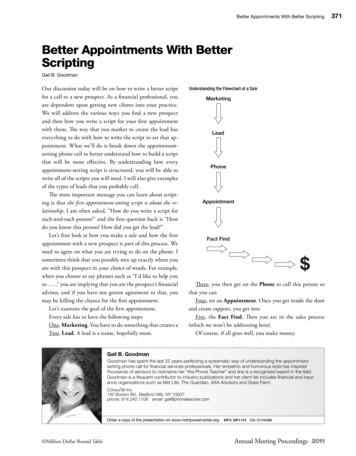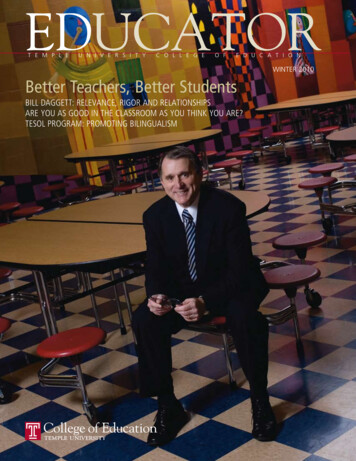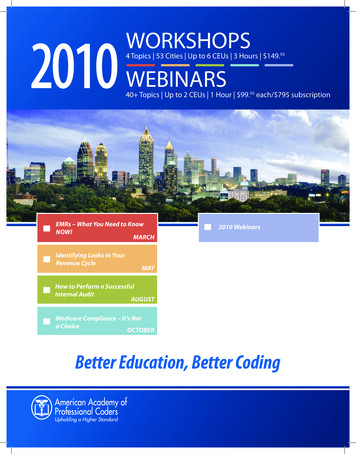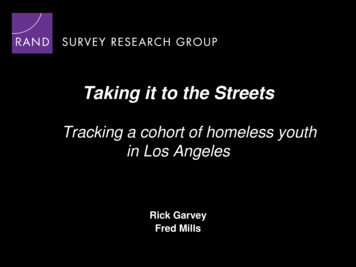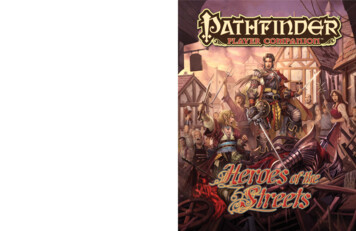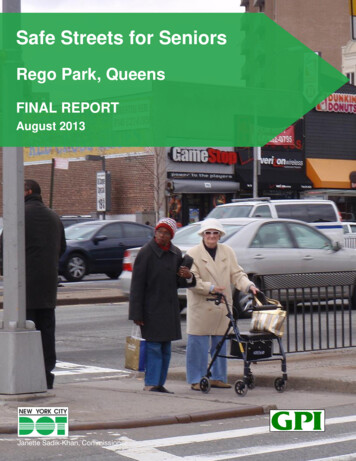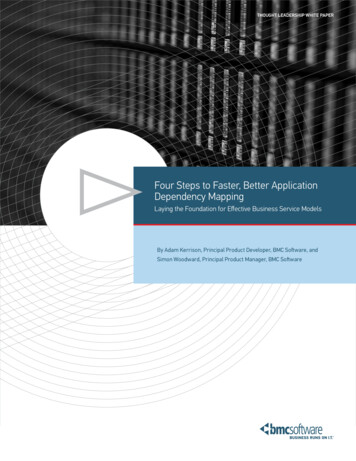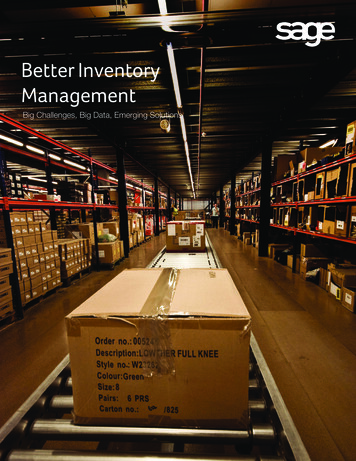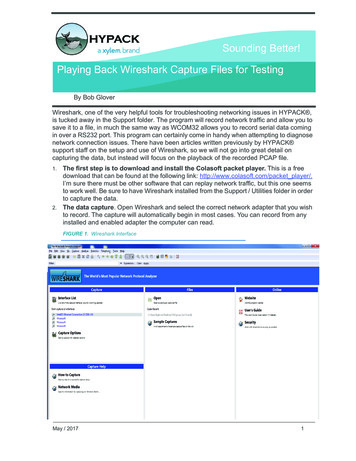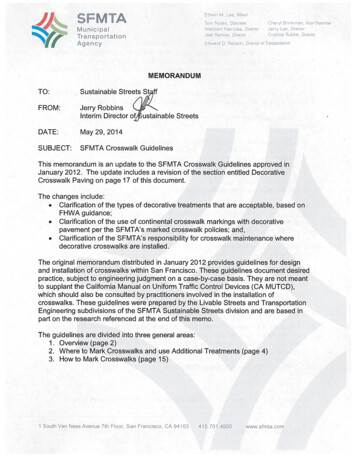
Transcription
1. OVERVIEWCrosswalks exist at all non-alley 1 intersections that meet at approximately right angles,whether marked or unmarked, except where pedestrian crossing is specificallyprohibited. Marked crosswalks serve to alert road users to expect crossing pedestriansand to direct pedestrians to desirable crossing locations.At mid-block locations, crosswalks only exist where marked. At these non-intersectionlocations, it is the crosswalk markings that legally establish the crosswalk.The following guidelines cover where and how to mark crosswalks, including thefollowing topics: Marking crosswalks at controlled intersection locationsMarking crosswalks at uncontrolled intersection locationsMarking crosswalks at mid-block locationsMarking crosswalks within school areasCrosswalk closuresCrosswalk marking patternsAdditional crosswalk safety treatmentsThese guidelines are consistent with Section 3B.17 of the 2009 MUTCD, which at thistime is pending official adoption by California. These guidelines are not meant to berigid standards, but rather to provide additional guidance subject to engineeringjudgment on a case-by-case basis.The following legal definitions and right-of-way control excerpts are from the CaliforniaVehicle Code (CVC).CVC Section 275. Crosswalk is either:(a) That portion of a roadway included within the prolongation or connection of theboundary lines of sidewalks at intersection where the intersecting roadways meet atapproximately right angles, except the prolongation of such lines from an alleyacross a street.(b) Any portion of a roadway distinctly indicated for pedestrian crossing by lines or othermarkings on the surface. Notwithstanding the foregoing provisions of this section,there shall not be a crosswalk where local authorities have placed signs indicatingno crossing.CVC Section 21950. Right-of-Way at Crosswalks:1Per the California Vehicle Code Section 110, alleys are generally minor streets that are 25 feet ornarrower in width.SFMTA Crosswalk GuidelinesPage 2 of 19
(a) The driver of a vehicle shall yield the right-of-way to a pedestrian crossing theroadway within any marked crosswalk or within any unmarked crosswalk at anintersection, except as otherwise provided in this chapter.(b) The provisions of this section shall not relieve a pedestrian from the duty of usingdue care for his or her safety. No pedestrian shall suddenly leave a curb or otherplace of safety and walk or run into the path of a vehicle which is so close as toconstitute an immediate hazard. No pedestrian shall unnecessarily stop or delaytraffic while in a marked or unmarked crosswalk.SFMTA Crosswalk GuidelinesPage 3 of 19
2. WHERE TO MARK CROSSWALKS AND USE ADDITIONAL TREATMENTSThe CA MUTCD provides the following guidance on where to mark crosswalks (Section3B.17):“In general, crosswalks should not be marked at intersections unless they areintended to channelize pedestrians. Emphasis is placed on the use of markedcrosswalks as a channelization device.The following factors may be considered in determining whether a markedcrosswalk should be used: Vehicular approach speeds from both directions. Vehicular volume and density. Vehicular turning movements. Pedestrian volumes. Roadway width. Day and night visibility by both pedestrians and motorists. Channelization is desirable to clarify pedestrian routes for sightedor sight impaired pedestrians. Discouragement of pedestrian use of undesirable routes. Consistency with markings at adjacent intersections or within thesame intersection.”The decision making processes for marking crosswalks is different depending onwhether the location is controlled or uncontrolled. Much of the following guidance onwhere to mark crosswalks is dedicated to uncontrolled locations.MARKING CROSSWALKS AT CONTROLLED INTERSECTION LOCATIONSIn San Francisco, unless pedestrian crossing is prohibited, marked crosswalks shouldbe provided at all intersection approaches controlled by traffic signals. Intersectionapproaches controlled by STOP signs can be recommended for marked crosswalks ifany of the following conditions apply: The crosswalk is located in a school area;OR,Elderly or disabled pedestrian volumes of 20 or more are expected during thepeak hour of pedestrian demand;OR,Pedestrian volumes of 60 or more are expected during the peak hour ofpedestrian demand and vehicular daily volumes of 6,000 or more are expected tocross over the crosswalk 2;2Many of the guidelines reviewed from other municipalities recommend marking crosswalks either at allapproaches controlled by STOP signs or when pedestrian volumes of 20 or more are expected during thepeak hour of pedestrian demand. However, San Francisco has many STOP sign controlled intersectionswith relatively low traffic volumes that would make these thresholds impractical.SFMTA Crosswalk GuidelinesPage 4 of 19
OR,Safety or efficiency reasons dictate directing pedestrians to a particular leg of theintersection;OR,STOP sign approaches are on a Minor Arterial or Major Arterial.MARKING CROSSWALKS AT UNCONTROLLED INTERSECTION LOCATIONSAt uncontrolled intersection approaches, crosswalks should only be marked if thefollowing conditions apply: There is sufficient demand (see Demand section below);AND,The location is more than 300 feet from a controlled crossing location 3;AND,Adequate stopping sight distance exists between approaching motorists andpedestrians starting to cross the street at the crosswalk;AND,The location has street lighting adjacent to the crosswalk;AND,Safety considerations arising from roadway configuration, vehicle volumes orvehicle speeds do not preclude marking a crosswalk (see RoadwayConfiguration, Motor Vehicle Volume and Speed section below).DemandAt uncontrolled intersection approaches, crosswalks should be considered for markingonly if there is sufficient demand according to the following criteria: The crosswalk is located in a school area;OR,Pedestrian volumes of 15 or more per hour are expected during multiple hoursthroughout the day;OR,Pedestrian volumes of 20 or more are expected during the peak hour of pedestriandemand;AND,Pedestrians have fewer than five gaps in traffic per five-minute period. 4MARKING CROSSWALKS AT MID-BLOCK LOCATIONSMid-block crosswalks only exist if marked and must be established by a SFMTA Boardof Directors’ resolution. Because pedestrian crossings may not be expected bymotorists at mid-block locations, additional measures such as signage and parkingrestrictions are recommended. Bulbouts are another desirable feature to improve3This guideline is used by several other municipalities including Sacramento, Stockton, Boulder, VirginiaDOT and more.4This guideline is used by several other municipalities including Palo Alto, Boulder, Sacramento,Stockton, San Leandro, Virginia DOT and more.SFMTA Crosswalk GuidelinesPage 5 of 19
visibility for both pedestrians and motorists but typically require special funding sourcesdue to their relatively high cost. Curb ramps are required. On higher volume and speedstreets a traffic signal may be required.Mid-block crosswalks should only be established if the following conditions apply: There is sufficient demand (see Demand section below);AND, The location is more than 300 feet from a controlled crossing location 5;AND, Adequate stopping sight distance exists between approaching motorists andpedestrians starting to cross the street at the proposed crosswalk;AND, The location has adequate street lighting to illuminate the proposed crosswalk;AND, Safety considerations arising from roadway configuration, vehicle volumes orvehicle speeds do not preclude establishing a crosswalk (see RoadwayConfiguration, Motor Vehicle Volume and Speed section below).DemandMid-block crosswalks should be considered only if there is a sufficient demandaccording to the following criteria: Pedestrian volumes of 40 or more are expected during the peak hour ofpedestrian demand;OR, Significant pedestrian trip generators (such as a school, park, or commercialbuilding) are on both sides of the street between controlled intersections. 6ROADWAY CONFIGURATION, MOTOR VEHICLE VOLUME AND SPEEDThe table provided in the Appendix is from the Federal Highway Administration studySafety Effects of Marked vs. Unmarked Crosswalks at Uncontrolled Locations and canbe used as a reference when deciding whether to mark a crosswalk at an uncontrolledlocation. For different roadway configurations, the table identifies ranges of vehiclespeeds and volumes where crosswalks can be marked without additional treatments(C), where additional treatments should be considered along with crosswalk markings(P), and where crosswalks should not be marked without additional treatments (N).Below is a flowchart offering further assistance with the decision of whether or not tomark a crosswalk at an uncontrolled location, and what, if any, additional treatmentsshould be considered. The flowchart and accompanying tables do not apply tocrosswalks within school areas (see School Area Crosswalks section on page 14).5This guideline is used by several other municipalities including Sacramento, Stockton, Boulder, VirginiaDOT and more.6These demand guidelines are used by several other municipalities including San Leandro, Palo AltoBoulder, Sacramento, Stockton, Virginia DOT and more.SFMTA Crosswalk GuidelinesPage 6 of 19
Where safety concerns persist even with special treatments (extreme cases of category“N” above), traffic signal warrants established in the most current CA MUTCD should befollowed to determine whether the crossing warrants a traffic signal. Pedestriancrossing distance alone is not a sufficient reason to consider new traffic signals. If atraffic signal is determined to be unwarranted or infeasible, other pedestrian treatmentssuch as medians and bulbouts should be considered.SFMTA Crosswalk GuidelinesPage 7 of 19
CROSSWALK MARKING FLOWCHART FOR UNCONTROLLED LOCATIONSSFMTA Crosswalk GuidelinesPage 8 of 19
CATEGORY A: TWO LANE STREETS(Meeting requirements of flowchart on page 6)TRAFFIC VOLUMEPOSTED SPEED(ADT)Up to 12,000 vehiclesper day30 MPH or lessConsider Level 1device (see page 11)35 MPHConsider Level 1device (see page 11)12,000 vehicles ormore per dayConsider Level 1device (see page 11)Marked X-walk andadditional Level 1device (see page 11).SFMTA Crosswalk Guidelines40 MPH or moreMarked X-walk plusadditional Level 1device and considerLevel 2 device (seepage 11)Marked X-walk plusadditional Level 1and/or Level 2devices. Evaluate thelocation for a trafficsignal (Level 3device) using CAMUTCD warrants(see page 11)Page 9 of 19
CATEGORY B: THREE LANE STREETS(Meeting requirements of flowchart on page 6)TRAFFIC VOLUMEPOSTED SPEED(ADT)9,000 vehicles orfewer per day30 MPH or lessConsider Level 1device (see page 11)35 MPHConsider Level 1device (see page 11)9,000-12,000vehicles per dayConsider Level 1device (see page 11)12,000-15,000vehicles per dayMarked X-walk plusadditional Level 1device and considerLevel 2 device (seepage 11)Marked X-walk plusadditional Level 1device and considerLevel 2 device (seepage 11)15,000 vehicles ormore per daySFMTA Crosswalk GuidelinesMarked X-walk plusadditional Level 1and consider Level 2devices. Evaluatethe location for atraffic signal (Level 3device) using CAMUTCD warrants(see page 11)40 MPH or moreMarked X-walk plusadditional Level 1device and considerLevel 2 device (seepage 11)Marked X-walk plusadditional Level 1and/or Level 2devices. Evaluatethe location for atraffic signal (Level 3device) using CAMUTCD warrants(see page 11)Page 10 of 19
CATEGORY C: FOUR OR MORE LANES WITH A RAISED MEDIAN(Meeting requirements of flowchart on page 6)TRAFFIC VOLUMEPOSTED SPEED(ADT)9,000 vehicles orfewer per day30 MPH or lessConsider Level 1device (see page 11)9,000-12,000vehicles per day12,000-15,000vehicles per day15,000 vehicles ormore per dayMarked X-walk plusadditional Level 1device and considerLevel 2 device (seepage 11)Marked X-walk plusadditional Level 1and consider Level 2devices. Evaluatethe location for atraffic signal (Level 3device) using CAMUTCD warrants(see page 11)SFMTA Crosswalk Guidelines35 MPHConsider Level 1device (see page 11)Marked X-walk plusadditional Level 1device and considerLevel 2 device (seepage 11)40 MPH or moreMarked X-walk plusadditional Level 1and/or Level 2devices. Evaluatethe location for atraffic signal (Level 3device) using CAMUTCD warrants(see page 11)Marked X-walk plusadditional Level 1and consider Level 2devices. Evaluatethe location for atraffic signal (Level 3device) using CAMUTCD warrants(see page11)Page 11 of 19
CATEGORY D: FOUR OR MORE LANES WITHOUT A RAISED MEDIAN(Meeting requirements of flowchart on page 6)TRAFFIC VOLUMEPOSTED SPEED(ADT)9,000 vehicles orfewer per day30 MPH or lessConsider Level 1device (see page 11)9,000-12,000vehicles per dayMarked X-walk andMarked X-walk andadditional Level 1additional Level 1device (see page 11). device (see page 11).12,000 vehicles ormore per dayEvaluate the locationfor a pedestriansignal. If the locationdoes not meet thewarrant, installmarked X-walk plusadditional Level 1and 2 devices ( seepage 11)SFMTA Crosswalk Guidelines35 MPHMarked X-walk andadditional Level 1device (see page 11).Evaluate the locationfor a pedestriansignal. If the locationdoes not meet thewarrant, installmarked X-walk plusadditional Level 1and 2 devices ( seepage 11)40 MPH or moreMarked X-walk plusadditional Level 1and/or Level 2devices. Evaluatethe location for atraffic signal (Level 3device) using CAMUTCD warrants (see page 11)Evaluate the locationfor a pedestriansignal. If the locationdoes not meet thewarrant, installmarked X-walk plusadditional Level 1and 2 devices ( seepage 11)Page 12 of 19
ADDITIONAL TREATMENTS FOR CROSSWALKS AT UNCONTROLLEDLOCATIONSA partial list of additional treatments to be considered for crosswalks at uncontrolledlocations is provided below. Specific circumstances will call for flexibility in application,and a combination of treatments may be appropriate.Level One (lower cost traffic control devices) Signage, including the “Yield Here to Pedestrians”, “Yield to Pedestrians inCrosswalk” metal and pop-up signs, and “Pedestrian Warning”, as discussed inthe CA MUTCD; Advance Stop and Yield Lines (see discussion on page 14); Raised pedestrian refuge islands; PED XING pavement markings installed on the approaches to the crosswalk; Parking prohibitions or red zones at the crosswalk; and, Speed limit signs or changes in conformance with an engineering study andCVC regulations.Level Two (higher cost traffic control devices and street changes) Flashing beacons used alone or in conjunction with overhead signs asapproved for general use by the CA MUTCD; In-roadway warning lights as approved for general use by the CA MUTCD; Curb extensions or bulbouts; Road diets or other traffic lane changes to reduce number of approach lanes orallow the installation of pedestrian refuge islands or medians; Traffic calming or other appropriate engineering measures to reduce roadwayspeeds; Pedestrian Hybrid Beacons (HAWK) as approved for general use by the CAMUTCD; and, Rectangular Rapid Flash Beacon following guidelines set forth in the FHWA’sinterim approval for optional use.Level Three (traffic signalization) Traffic signals should be used where other treatments are infeasible orineffective and current CA MUTCD traffic signal warrants are met.REMOVING CROSSWALK MARKINGSThese guidelines should not be used to justify removal of existing crosswalk markings.In most circumstances additional measures should be considered prior to removal ofcrosswalk markings. In exceptional cases crosswalk markings can be recommended fordeletion while leaving a crosswalk open, such as when an engineering evaluationindicates that other measures have not been effective and there are significant safetyadvantages to not marking the crosswalk. Removing a marked crosswalk requires apublic hearing under the Pedestrian Safety Act of 2000 (AB 2522). Consult CVCSection 21950.5 for more details about the 30-day minimum public notificationrequirements.SFMTA Crosswalk GuidelinesPage 13 of 19
CROSSWALK CLOSURESClosures of existing crosswalks should be avoided, and existing closed crosswalksshould be evaluated for opening, which may necessitate additional safety measuressuch as traffic signal timing or signage changes.In exceptional cases, closing a crosswalk or keeping a crosswalk closed may bejustified even if a crosswalk meets the guidelines outlined elsewhere in theseguidelines. Where crosswalk closures are required, only one leg of an intersectionshould be closed. Closing a crosswalk with signs and barriers may be justified by suchfactors as heavy turn volumes, poor sight distance, or very low pedestrian demand.The extent of inconvenience for pedestrians must be considered in these decisions.Closing a crosswalk requires a public hearing and a SFMTA Board of Directors’resolution.SFMTA Crosswalk GuidelinesPage 14 of 19
3. HOW TO MARK CROSSWALKSAll marked crosswalks other than designated school area crosswalks shall be white. Allcrosswalks should be marked using thermoplastic treated with retroreflective glassbeads upon installation. The width of a crosswalk should generally conform to sidewalkwidth, but can be wider in locations with high pedestrian demand or narrow sidewalks.The minimum recommended crosswalk width is 10 feet.CROSSWALK MARKING PATTERNSVarious crosswalk marking patterns exist in San Francisco, including continental,transverse, and ladder, as shown in Figure I below. Until recently, San Francisco onlyused continental markings at mid-block and school area crosswalks. It is now the goalof the Sustainable Streets Division to gradually have all crosswalk markings beconverted to the continental marking pattern. Existing transverse markings should beprioritized for conversion to continental markings as resources allow; recognizingresource limitations, this policy will be implemented slowly over time. When transversemarkings are converted to continental markings, the side stripes may remain, sinceremoval is costly, but the side stripes should not be maintained.FIGURE I: Crosswalk Marking PatternsContinentalTransverseLadderContinental stripes should be two feet wide and should be painted parallel to the curb.The minimum spacing between continental stripes is two feet, although this spacingmay be consistent or staggered. Staggered continental stripes may be used to avoidwheel paths as shown in Figure II on page 14. Because of their potential to reduce longterm maintenance, staggered continental stripes are the preferred continental markingpattern and should be used at new installations and after roadway repaving. Forstaggered continental details, see Striping Drawing STR 7821.SFMTA Crosswalk GuidelinesPage 15 of 19
FIGURE II: Staggered Continental Crosswalk LayoutSCHOOL AREA CROSSWALKSCrosswalks marked in locations directly adjoining Kindergarten through 12th gradeschools in California are considered school area crosswalks and must be marked inyellow. When one crosswalk is marked in yellow, all crosswalks at the same intersectionmust be marked in yellow. CVC Section 21368 regulates which crosswalk locations notdirectly adjoining schools can be considered school area crosswalks to be marked inyellow. Yellow school area crosswalks at uncontrolled approaches must beaccompanied by SLOW SCHOOL XING pavement markings in each approaching laneand appropriate signage. Refer to Chapter 7 of the CA MUTCD and CVC Section 21368for additional guidance.ADVANCE STOP AND YIELD LINESAdvance stop and yield lines can be a tool for improving pedestrian safety on streetswith multiple threat scenarios. 7 Advance yield lines are not typically used for single laneapproaches unless justified by unique conditions. Guidelines for advance stop and yieldlines can be found under Section 3B.16 of the CA MUTCD, which allows for their usefrom
Boulder, Sacramento, Stockton, Virginia DOT and more. SFMTA Crosswalk Guidelines Page 7 of 19 Where safety concerns persist even with special treatments (extreme cases of category “N” above), traffic signal war
